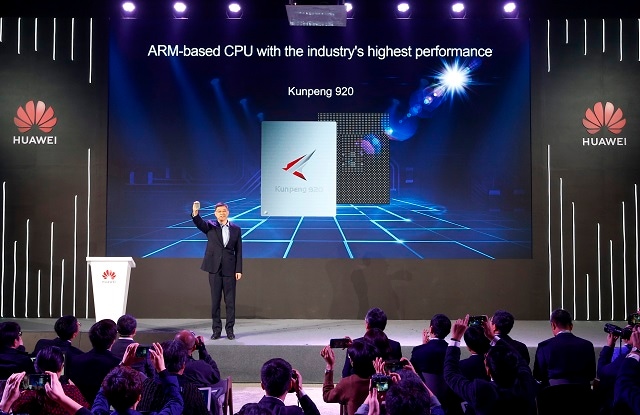Huawei has launched the industry's highest-performance ARM-based CPU.
The 7nm Kunpeng 920 is aimed at data, distributed storage, and ARM-native application applications and is based on ARMv8 architecture license. It significantly improves processor performance by optimizing branch prediction algorithms, increasing the number of OP units, and improving the memory subsystem architecture.
At typical frequencies, the Kunpeng 920 CPU scores over 930 in the SPECint Benchmarks test, which is 25% higher than the industry benchmark. At the same time, power efficiency is 30% better than that offered by industry counterparts. Kunpeng 920 integrates 64 cores at a frequency of 2.6 GHz alongside 8-channel DDR4.
System integration is also increased significantly through the two 100G RoCE ports as well as PCIe 4.0 and CCIX interfaces, providing 640 Gbps total bandwidth. In addition, the single-slot speed is twice that of the incumbent offering, effectively improving the performance of storage and various accelerators.

"Huawei has continuously innovated in the computing domain in order to create customer value. We believe that, with the advent of the intelligent society, the computing market will see continuous growth in the future. Currently, the diversity of applications and data is driving heterogeneous computing requirements. Huawei has long partnered with Intel to make great achievements. Together we have contributed to the development of the ICT industry. Huawei and Intel will continue our long-term strategic partnerships and continue to innovate together," said William Xu, Director of the Board and Chief Strategy Marketing Officer of Huawei (above).
"At the same time, the ARM industry is seeing a new development opportunity. The Kunpeng 920 CPU and TaiShan servers newly released by Huawei are primarily used in big data, distributed storage, and ARM-native applications. We will work with global partners in the spirit of openness, collaboration, and shared success to drive the development of the ARM ecosystem and expand the computing space, and embrace a diversified computing era."
Huawei has released its TaiShan series servers powered by Kunpeng 920, including three models: one with a focus on storage, another on high density, and a third focused on balancing both requirements. The TaiShan servers are built for big data, distributed storage, and ARM-native application scenarios.
TaiShan will enable computing platforms with high performance and low power consumption for enterprises. For example, in big data scenarios, the TaiShan servers are tuned for optimal many-core high concurrency and resource scheduling to deliver a 20% computing performance boost. Based on the TaiShan servers, Huawei Cloud also provides elastic cloud services, bare metal services, and cloud phone services.
Huawei has been working with industry organizations such as Green Computing Consortium (GCC), Linaro, and Open Edge and HPC Initiative (OEHI) to build an open, collaborative industry ecosystem, alongside partners such as Hortonworks, Microsoft, Oracle, SAP, SUSE, Ubuntu, and China Standard Software.
On the hardware side, Huawei is a core member of Linaro. On the basic software side, Huawei is a Platinum member of the OpenStack Foundation and a founding member of Cloud Native Computing Foundation (CNCF). With regard to applications, Huawei has joined the GCC. GCC has released the Green Computing Consortium Server Technical Standards Report, along with other efforts to build a green open source computing community. Huawei is also a member of the OEHI.
The development and convergence of ARM-based applications on smart terminals are accelerating, along with cloud-device collaboration, with new applications in cloud computing driving data diversity. For example, big data applications, distributed storage, and some edge computing scenarios have specific energy efficiency requirements for many-core high-performance computing.
Related stories:

No comments:
Post a Comment